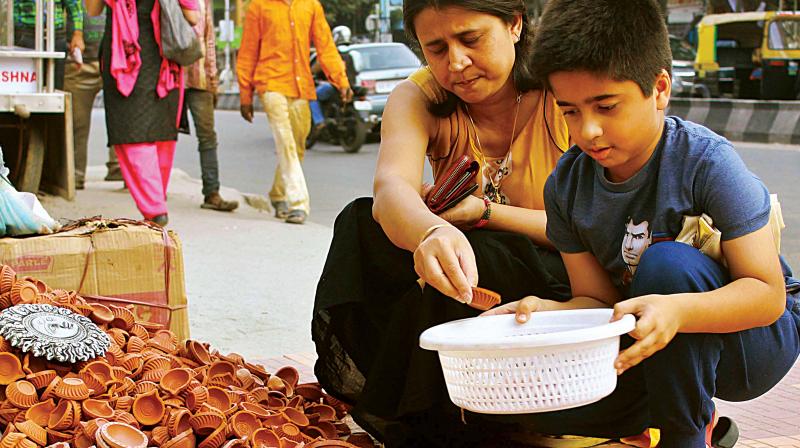Diwali: Demand for plastic, Chinese products falls this year in Bengaluru
The leftover diyas are stored away for the next year and during off seasons, they bake kulfi pots.

Bengaluru: Following the trend of clay Ganeshas that not only cut down water pollution considerably, but also lent a helping hand to the potter community, Bengalureans this Diwali turned to clay diyas to light up their homes.
“The demand for clay diyas was at an all-time high. Customers came seeking only clay diyas. They refused to buy the Chinese diyas that we sold earlier. Even when we sell on wholesale, they wanted to buy only the clay ones. It’s good for us. I’ve made almost Rs 2 lakh profit,” said G. Rajashekhar, one of the oldest potters in town. His establishment in Pottery Town was started in 1992 by his great grandfather and the family continues his legacy today. Huddled up in his attic with a clutter of hundreds of newly made diyas in various designs around him, he paints the diyas with a spray gun. His wife and children also lend a hand during Diwali festivities. “We all pitch in and my wife is also from a family of potters, so it is perfectly matched. My younger daughter wants to continue the family business, so thankfully I won’t be the last one,” he says.
In the business for the last 48 years now, he makes around 30,000 diyas each Diwali. The clay he uses is of superior quality and it is getting harder to get, he claims. “With all the lakes closed in the city, we have to bring clay from outside and it costs more. It is measured in a tempo loads and one unit costs about Rs 7,000,” he says.
Bengaluru being a hub of cross-cultures, North Indian style diyas are also picking up on sale, he says. “We import from Rajasthan., Kolkata and Gujarat. All clay diyas, but with different designs. We pay about Rs 6-7 lakh for the consignment and make a profit of about Rs 1.5 lakh. Now, we are learning to make them here,” he says.
Another potter, 22-year-old Vijay Kumar, who has been making clay pots for almost 17 years now, says, “For the last five years, people have been asking for organically coloured and chemical free diyas. But this Diwali, it really picked up. I haven’t sold any plastic or Chinese diyas this year.”
He says. “My great grandfather came from Madakasira, a village on the Andhra Pradesh-Karnataka border, and settled down here. He started it as a small business, and it has been passed on from generation to generation.” He says, “The clay is brought from Hoskote and outskirts of the city. We filter it and then mix it with water. It is then moulded and sun dried, after which we bake it in the fire.”
Kumar, along with his parents and younger brother, makes almost 400 diyas a day. “We work for almost nine hours. It’s always better to let diyas soak up more sun.”
The leftover diyas are stored away for the next year and during off seasons, they bake kulfi pots. “Contrary to popular belief, it is quite profitable. We sell cups and kulfis for restaurants. The demand has picked up since the plastic ban,” he says.

